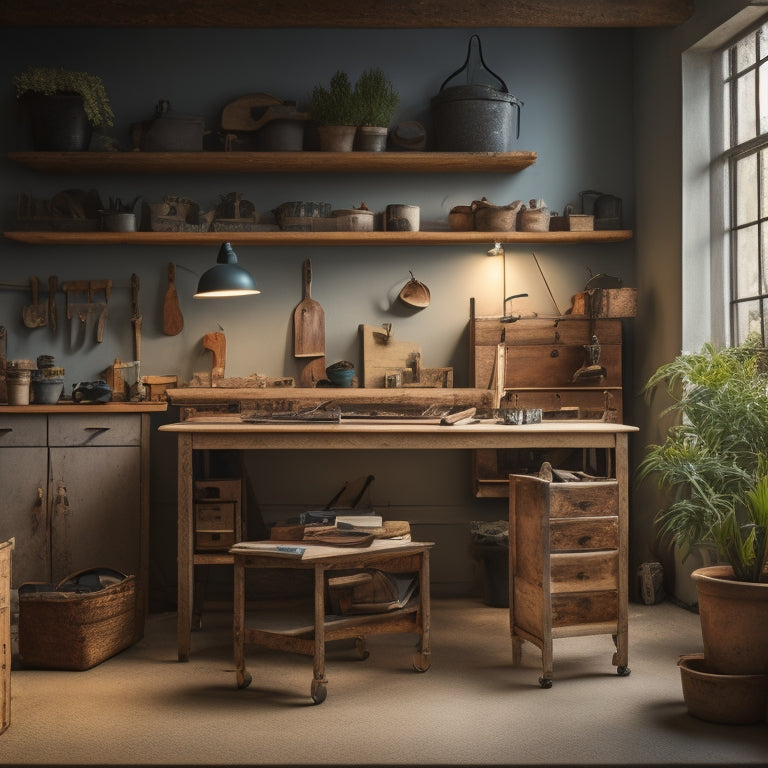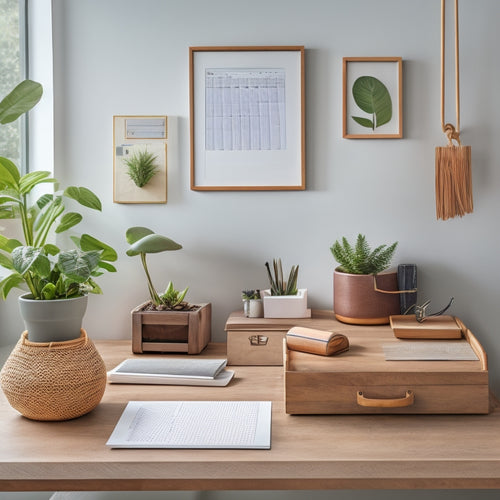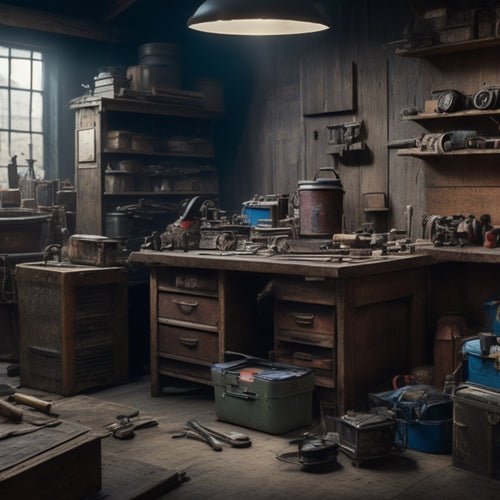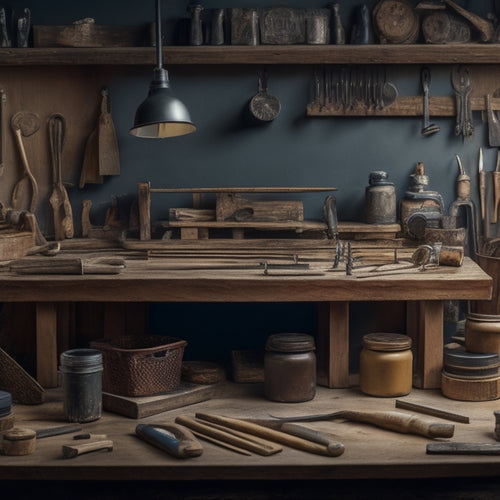
Work Benches With Drawers for Efficient Workspace Organization
Share
You're looking to optimize your workspace with workbenches featuring drawers, and that's a great start! By incorporating these into your setup, you'll enjoy increased efficiency, improved organization, and enhanced security. With customizable storage, you can tailor your workspace to specific needs, reducing clutter and the risk of accidents. When choosing the right workbench, consider factors like space availability, comfortable fit, and ergonomic design. Once you've got the perfect bench, you can start customizing your drawers with organizers, dividers, and trays to maximize storage and streamline your workflow. Now, take the next step and investigate how you can further optimize your workspace organization.
Key Takeaways
- Workbenches with drawers increase efficiency by providing easy access to tools and materials, reducing search time and enhancing task completion speed.
- Customizable drawer configurations and organizer options enable tailored storage solutions that optimize workspace design and reduce clutter.
- Proper workbench sizing and ergonomic considerations, including adjustable heights and anti-fatigue mats, promote a safe and comfortable work environment.
- Drawer materials, such as metal or wood, affect load capacity, durability, and maintenance needs, making informed choices essential for optimal performance.
- Incorporating dividers, trays, and inserts within drawers streamlines tool organization, reduces search time, and enhances overall workspace efficiency.
Benefits of Workbench Drawers
Three key advantages of workbench drawers are increased efficiency, improved organization, and enhanced security. When you have a workbench with drawers, you can easily access the tools and materials you need, reducing the time spent searching for them. This increases your workspace efficiency, allowing you to complete tasks quickly and effectively.
Additionally, workbench drawers help you keep your workspace organized by providing a dedicated space for storing items. This prevents clutter from building up on your work surface, reducing the risk of accidents and injuries. You'll also be able to find what you need quickly, which is especially important in high-pressure situations.
Moreover, workbench drawers enhance security by providing a secure space to store important tools and equipment. With your tools locked away, you can minimize the risk of theft or damage.
In addition, drawer functionality allows you to customize your storage space to fit your specific needs, ensuring that your workspace is designed to your unique requirements.
Choosing the Right Workbench Size
You'll need to assess the space where your workbench will go to determine the maximum size it can be.
Consider the room's dimensions, any obstacles, and the space you'll need to move around the bench.
Space Availability Assessment
Before selecting a workbench with drawers, assess the available space in your workshop or garage to determine the ideal size for your needs.
You'll want to guarantee the workbench fits comfortably, leaving enough room to move around and work efficiently. Measure the width, length, and height of the area where you plan to install the workbench.
Take note of any obstacles, such as pipes, electrical outlets, or windows, that may impact the workbench's placement.
Consider the workspace layout and how the workbench will be used. Will you need to access tools and materials frequently? Do you prefer a compact workbench or one with ample surface area?
Accurate space measurement is essential to choosing the right workbench size. Record the measurements and compare them to the dimensions of potential workbenches.
This will help you narrow down your options and select a workbench that fits seamlessly into your workspace, promoting a safe and organized work environment.
Optimal Bench Dimensions
With your space measurements in hand, it's time to determine the ideal bench dimensions for your workbench with drawers. You'll want to take into account the available floor space, the type of work you'll be doing, and the number of users to guarantee your workbench is comfortable and efficient.
When choosing the right workbench size, take into account the following ideal dimensions:
| Width | Depth | Height |
|---|---|---|
| 30-36 inches | 60-72 inches | 29-30 inches |
| 36-42 inches | 72-84 inches | 30-31 inches |
| 42-48 inches | 84-96 inches | 31-32 inches |
| 48-60 inches | 96-120 inches | 32-33 inches |
Height considerations are vital for safety and comfort. A workbench that's too high or too low can lead to discomfort, fatigue, and even injury. Aim for a height that allows you to stand comfortably with your arms at a 90-degree angle and your elbows at a 45-degree angle.
Types of Workbench Drawer Materials
What makes a workbench drawer material ideal for your specific needs? When choosing between metal vs wood drawers, consider factors like durability, load capacity, and maintenance requirements.
Metal drawers are a popular choice for heavy-duty applications, as they can withstand high weights and are less prone to warping or cracking. However, they can be noisy and may rust if not properly coated.
Wooden drawers, on the other hand, offer a more traditional look and feel, but may be more susceptible to damage from moisture or heavy loads.
Drawer load is a critical consideration, especially if you plan to store heavy tools or equipment. Metal drawers typically have a higher load capacity than wood drawers, but this can also depend on the specific design and construction of the drawer.
Additionally, consider the type of metal or wood used, as some materials may be more durable or resistant to wear and tear than others.
Customizing Your Workbench Drawers
You've chosen your workbench and selected the perfect drawer material, now it's time to customize your drawers to fit your specific needs.
You'll want to contemplate the ideal size of your drawers based on the tools and supplies you'll be storing, as well as the available space on your workbench.
From there, you can investigate various organizer options and custom configurations to maximize efficiency and productivity.
Drawer Size Considerations
When designing custom workbench drawers, determining the ideal size is essential to maximize storage and workflow efficiency.
You'll want to contemplate the types of tools and materials you'll be storing, as well as the available space in your workshop.
To get started, think about the drawer width. Will you need narrow drawers for small hand tools or wider drawers for larger power tools? Typically, drawer widths range from 12 to 36 inches, but you can customize them to fit your specific needs.
Next, reflect on the drawer depth. Shallow drawers are great for small items like fasteners or supplies, while deeper drawers can accommodate larger items like drills or saws.
Drawer depths usually range from 12 to 24 inches.
Remember to also think about the height of your workbench and the clearance needed to open and close the drawers comfortably.
Drawer Organizer Options
Several drawer organizer options are available to customize your workbench drawers and maximize storage efficiency. You can choose from various drawer types, such as ball-bearing, soft-close, or heavy-duty drawers, each designed to meet specific needs.
To optimize your drawer space, consider adding drawer accessories like dividers, trays, or inserts. These organizers help keep tools and materials organized, making it easier to find what you need when you need it.
Here is a comparison of popular drawer organizer options:
| Organizer Type | Description | Benefits |
|---|---|---|
| Dividers | Separate drawers into compartments | Prevents clutter, improves visibility |
| Trays | Holds small items like screws or nuts | Keeps tiny parts organized, reduces loss |
| Inserts | Customizable compartments for specific tools | Maximizes storage, reduces searching time |
| Tool Holders | Secures tools like hammers or pliers | Keeps frequently used tools within reach |
Custom Drawer Configurations
Configuring your workbench drawers to meet your specific needs is an essential step in maximizing storage efficiency and streamlining your workflow. When customizing your workbench drawers, you'll want to take into account various drawer layout strategies to guarantee everything has a designated place. This will help prevent clutter and make it easier to find what you need quickly.
You can choose from adjustable compartments, dividers, and inserts to create a customized storage system that suits your requirements. For instance, you might need separate compartments for small parts, tools, or materials. Adjustable compartments allow you to modify the layout as your needs change, making certain your workspace remains organized and efficient.
When designing your custom drawer configuration, think about the frequency of use, size, and type of items you'll be storing. This will help you determine the best layout and make certain that your most frequently used items are easily accessible.
Maximizing Storage With Dividers
Maximizing Storage With Dividers
By incorporating dividers into your workbench design, you can effectively separate tools and materials, making it easier to find what you need in a flash. This not only saves you time but also reduces the risk of accidents caused by cluttered workspaces. Dividers come in various types, each suited for specific storage needs.
| Divider Type | Description | Suitable for |
|---|---|---|
| Adjustable Dividers | Can be customized to fit different sizes of tools and materials | Flexible storage needs |
| Fixed Dividers | Provide fixed compartments for storing specific items | Organizing small parts and accessories |
| Sliding Dividers | Allow for easy access to stored items | Frequently used tools and materials |
| Stackable Dividers | Can be stacked to create multiple storage levels | Maximizing vertical storage space |
When designing your drawer layout, consider the types of dividers that will best suit your storage needs. By incorporating dividers into your workbench design, you can create a more organized and efficient workspace that promotes productivity and safety.
Workbench Drawer Security Options
Beyond organizing your tools and materials, securing your workbench drawers is essential to prevent theft, damage, or unauthorized access.
You'll want to evaluate various lock types and drawer locks that fit your specific needs. Keyless entry systems, for instance, offer convenient access control without the hassle of physical keys. Some workbenches come equipped with advanced security features, such as electronic locks with programmable codes or biometric authentication.
When selecting a workbench, look for safety measures like tamper-evident locks or recessed locking mechanisms that prevent forced entry. Additionally, assess the level of access control you need – do you want to restrict access to certain drawers or the entire workbench?
Ergonomic Considerations for Comfort
Your workbench should be designed to promote comfort and reduce fatigue, allowing you to work efficiently for extended periods. When choosing a workbench, consider the ergonomic features that will support your well-being.
-
Proper Posture Alignment: Ascertain the workbench is at a comfortable height, allowing you to maintain a straight back and avoid straining your neck and shoulders.
-
Ergonomic Tools: Invest in tools with ergonomic grips and handles to reduce strain on your hands and wrists.
-
Comfortable Standing: Opt for a workbench with a mat or anti-fatigue floor mat to reduce discomfort and fatigue from standing for long periods.
- Adjustable Height: Select a workbench with adjustable height settings to accommodate different tasks and users, promoting comfort and diminishing the risk of injury.
Workbench Drawer Organization Ideas
Organize your workbench drawers to enhance productivity and reduce frustration. A well-organized workspace is essential for efficiency and safety. Start by categorizing your tools and supplies into groups, such as hand tools, power tools, and materials. Assign a specific drawer to each group to maintain a logical flow.
Implement a tool organization system within each drawer using dividers, bins, or trays. This will prevent tools from getting jumbled and make them easily accessible. Label each drawer and its contents using clear and concise labels. This guarantees you can quickly find what you need, reducing downtime and increasing productivity.
Use adjustable dividers to customize the space according to your specific needs. Consider using a pegboard or a magnetic strip to store frequently used tools, freeing up drawer space for less frequently used items.
Maintenance Tips for Durability
Set up a regular cleaning schedule to keep your workbench drawers in top condition. This will help prevent dirt and debris from building up and causing damage to the drawers or their contents.
To maintain your drawers' durability, follow these essential maintenance routines:
-
Dust regularly: Use a soft-bristled brush or a dry cloth to wipe away dust and dirt from the drawers and their contents.
-
Lubricate moving parts: Apply silicone spray or lubricant to the drawer slides and hinges to keep them running smoothly and avert rust.
-
Clean up spills immediately: Wipe up any spills or messes as soon as they happen to prevent damage to the drawers or their contents.
- Tighten loose screws and bolts: Regularly check and tighten any loose screws or bolts on the drawers and their hardware to guarantee they remain secure.
Frequently Asked Questions
Can Workbench Drawers Be Installed on an Existing Workbench?
You can install workbench drawers on an existing workbench, but it'll require careful planning and execution; consider drawer installation tips, such as measuring accurately, and be prepared for workbench modifications, like drilling and reinforcing, to guarantee a safe and sturdy setup.
Are Workbench Drawers Suitable for Outdoor or Garage Use?
You'll be surprised to know that 75% of homeowners use their garage for storage, making weather-resistant workbench drawers a must-have. When choosing outdoor or garage workbench drawers, make certain they're built with rust-proof materials and consider the drawer capacity to withstand harsh conditions.
Do Workbench Drawers Come With Soft-Close or Soft-Open Mechanisms?
When you're shopping for workbench drawers, you'll likely find some with soft-close mechanisms, which reduce slamming and improve safety; however, soft-open features are less common, and you might need to contemplate custom drawer installation to achieve this benefit.
Can Workbench Drawers Be Locked or Secured With a Key?
You'll find that many drawer types, including ball-bearing and roller slides, can be locked or secured with a key, offering an added layer of security and control over your precious tools and materials.
Are Workbench Drawers Compatible With Different Work Surface Materials?
You'll find that most workbench drawers are compatible with various work surface materials, but it's vital to take into account the drawer materials and weight capacity to guarantee a safe and sturdy installation that meets your specific needs.
Conclusion
With your new workbench and drawers in place, you're now the ruler of your domain, ruling over a kingdom of organized chaos. Every tool is within arm's reach, every project is a breeze, and every minute is maximized. Your workspace is an orchestration of efficiency, with each component working in harmony to help you create, build, and innovate. Now, get to work and make the most of your newfound productivity!
Related Posts
-

Best Organizing Tools for a Clutter-Free Space
You're on a mission to change your cluttered space into a peaceful oasis, and you're looking for the best organizing ...
-

10 Best Tool Boxes for Every Budget and Job
You're looking for a tool box that fits your budget and job requirements. Whether you're a DIY enthusiast, electricia...
-

Top 5 Small Tool Organizers for Your Workshop
You're looking to optimize your workshop's efficiency with high-quality small tool organizers. Compact storage soluti...


